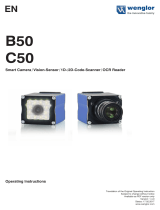
11.7 Image Menu (IMAGE) ..........................................................................................................133
11.8 Information Menu (INFO) .....................................................................................................
133
11.9 System Error Menu (SYSERR) ...............................................................................................134
11.10 Display Menu (DISPLAY) .................................................................................................... 134
11.11 Reboot Menu (REBOOT) .....................................................................................................134
12 Communications Guide ............................................................................................ 135
12.1 Communication Summary ....................................................................................................135
12.1.1 Communication Channels ........................................................................................... 135
12.1.2 Industrial Ethernet .................................................................................................... 135
12.1.3 Image Export ........................................................................................................... 135
12.2 Enabling Communications .................................................................................................... 136
12.2.1 Setting Up Ethernet Communications ...........................................................................136
12.2.2 Windows 7 ............................................................................................................... 136
12.2.3 Communications Channel Ports .................................................................................... 137
13 Industrial Ethernet Overview ...................................................................................138
13.1 Industrial Ethernet Setup .....................................................................................................138
13.1.1 Set the Industrial Ethernet Protocol (EtherNet/IP, PROFINET
®
, Modbus/TCP, PCCC) ...........138
13.1.2 Set the Trigger Mode .................................................................................................138
13.2 Supported Functions ........................................................................................................... 138
13.2.1 Sensor Input Values .................................................................................................. 139
13.2.2 Sensor Output Values ................................................................................................ 139
13.3 EtherNet/IP ........................................................................................................................139
13.3.1 Inputs to the Sensor (Outputs from the PLC) ................................................................ 142
13.3.2 Outputs from the Sensor (Inputs to the PLC) ................................................................ 143
13.3.3 Input and Output Bits ................................................................................................ 144
13.3.4 Sensor Pass/Fail Bits ..................................................................................................144
13.3.5 Tool-Specific Results: EtherNet/IP ................................................................................ 144
13.3.6 Configuration Assembly Object .....................................................................................146
13.3.7 Data Formats .............................................................................................................146
13.3.8 Minimum Requested Packet Inverval (RPI) Value ...........................................................146
13.3.9 VE Series Smart Camera EDS File Installation in ControlLogix Software ............................. 146
13.3.10 RSLogix5000 Configuration ........................................................................................152
13.4 Modbus/TCP .......................................................................................................................158
13.4.1 Sensor Input Values ................................................................................................... 163
13.4.2 Sensor Output Values ................................................................................................. 164
13.4.3 Input and Output Bits .................................................................................................164
13.4.4 Sensor Pass/Fail Bits ..................................................................................................165
13.4.5 Tool-Specific Results: Modbus/TCP .............................................................................. 165
13.5 PLC5 and SLC 5 (PCCC) .......................................................................................................166
13.5.1 Configuration ............................................................................................................169
13.5.2 Inputs to the Sensor (Outputs from the PLC) ................................................................. 173
13.5.3 Outputs from the Sensor (Inputs to the PLC) ................................................................. 173
13.5.4 Input and Output Bits .................................................................................................174
13.5.5 Sensor Pass/Fail Bits ..................................................................................................174
13.5.6 Tool-Specific Results: PCCC ........................................................................................174
13.6 PROFINET ...........................................................................................................................176
13.6.1 General Station Description (GSD) File ..........................................................................176
13.6.2 VE Series camera PROFINET IO Data Model ................................................................... 176
13.6.3 Configure the VE Series Smart Camera for a PROFINET IO Connection ............................. 176
13.6.4 Description of Modules and Submodules ........................................................................177
13.6.5 Description of Submodules ......................................................................................... 178
13.6.6 Configuration Instructions .......................................................................................... 184
13.7 Troubleshooting ..................................................................................................................194
13.7.1 Industrial Ethernet Error Codes ...................................................................................194
13.7.2 PROFINET ................................................................................................................. 194
14 Troubleshooting .......................................................................................................197
14.1 Vision Manager Error Codes ..................................................................................................197
15 Accessories ...............................................................................................................208
15.1 Cordsets ............................................................................................................................208
15.2 Brackets ............................................................................................................................208
15.3 Lenses .............................................................................................................................. 209
15.3.1 WVGA Lens Working Distance and Field of View ..............................................................209
15.3.2 1.3 MP Lens Working Distance and Field of View ............................................................210
15.3.3 2 MP Lens Working Distance and Field of View ...............................................................210
15.4 C-Mount Lens Filter Models .................................................................................................. 211
15.5 Lens Cover .........................................................................................................................211
15.6 Display Cover .....................................................................................................................212
15.7 Ring Lights .........................................................................................................................212
15.8 Interface Module .................................................................................................................212
15.9 Product CD ........................................................................................................................ 213
VE Series Smart Camera





















